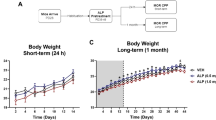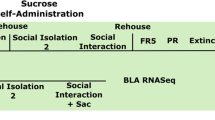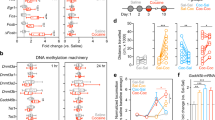Abstract
Stress and exposure to glucocorticoids (GC) during early life render individuals vulnerable to brain disorders by inducing structural and chemical alterations in specific neural substrates. Here we show that adult rats that had been exposed to in utero GCs (iuGC) display increased preference for opiates and ethanol, and are more responsive to the psychostimulatory actions of morphine. These animals presented prominent changes in the nucleus accumbens (NAcc), a key component of the mesolimbic reward circuitry; specifically, cell numbers and dopamine (DA) levels were significantly reduced, whereas DA receptor 2 (Drd2) mRNA expression levels were markedly upregulated in the NAcc. Interestingly, repeated morphine exposure significantly downregulated Drd2 expression in iuGC-exposed animals, in parallel with increased DNA methylation of the Drd2 gene. Administration of a therapeutic dose of L-dopa reverted the hypodopaminergic state in the NAcc of iuGC animals, normalized Drd2 expression and prevented morphine-induced hypermethylation of the Drd2 promoter. In addition, L-dopa treatment promoted dendritic and synaptic plasticity in the NAcc and, importantly, reversed drug-seeking behavior. These results reveal a new mechanism through which drug-seeking behaviors may emerge and suggest that a brief and simple pharmacological intervention can restrain these behaviors in vulnerable individuals.
This is a preview of subscription content, access via your institution
Access options
Subscribe to this journal
Receive 12 print issues and online access
$259.00 per year
only $21.58 per issue
Buy this article
- Purchase on Springer Link
- Instant access to full article PDF
Prices may be subject to local taxes which are calculated during checkout




Similar content being viewed by others
References
Piazza PV, Le Moal ML . Pathophysiological basis of vulnerability to drug abuse: role of an interaction between stress, glucocorticoids, and dopaminergic neurons. Annu Rev Pharmacol Toxicol 1996; 36: 359–378.
Heim C, Newport DJ, Mletzko T, Miller AH, Nemeroff CB . The link between childhood trauma and depression: insights from HPA axis studies in humans. Psychoneuroendocrinology 2008; 33: 693–710.
Andersen SL, Teicher MH . Desperately driven and no brakes: developmental stress exposure and subsequent risk for substance abuse. Neurosci Biobehav Rev 2009; 33: 516–524.
Sinha R . Chronic stress, drug use, and vulnerability to addiction. Ann N Y Acad Sci 2008; 1141: 105–130.
Rodrigues AJ, Leao P, Carvalho M, Almeida OF, Sousa N . Potential programming of dopaminergic circuits by early life stress. Psychopharmacology (Berl) 2010; 214: 107–120.
Seckl JR . Glucocorticoids, developmental ′programming′ and the risk of affective dysfunction. Prog Brain Res 2008; 167: 17–34.
Cerqueira JJ, Pego JM, Taipa R, Bessa JM, Almeida OF, Sousa N . Morphological correlates of corticosteroid-induced changes in prefrontal cortex-dependent behaviors. J Neurosci 2005; 25: 7792–7800.
Crane J, Armson A, Brunner M, De La Ronde S, Farine D, Keenan-Lindsay L et al. Antenatal corticosteroid therapy for fetal maturation. J Obstet Gynaecol Can 2003; 25: 45–52.
Brown RW, Chapman KE, Kotelevtsev Y, Yau JL, Lindsay RS, Brett L et al. Cloning and production of antisera to human placental 11 beta-hydroxysteroid dehydrogenase type 2. Biochem J 1996; 313 (Part 3): 1007–1017.
Seckl JR . Prenatal glucocorticoids and long-term programming. Eur J Endocrinol 2004; 151 (Suppl 3): U49–U62.
Oliveira M, Bessa JM, Mesquita A, Tavares H, Carvalho A, Silva R et al. Induction of a hyperanxious state by antenatal dexamethasone: a case for less detrimental natural corticosteroids. Biol Psychiatry 2006; 59: 844–852.
Leao P, Sousa JC, Oliveira M, Silva R, Almeida OF, Sousa N . Programming effects of antenatal dexamethasone in the developing mesolimbic pathways. Synapse 2007; 61: 40–49.
Koob GF, Volkow ND . Neurocircuitry of addiction. Neuropsychopharmacology 2010; 35: 217–238.
Meaney MJ, Brake W, Gratton A . Environmental regulation of the development of mesolimbic dopamine systems: a neurobiological mechanism for vulnerability to drug abuse? Psychoneuroendocrinology 2002; 27: 127–138.
Di Chiara G . Nucleus accumbens shell and core dopamine: differential role in behavior and addiction. Behav Brain Res 2002; 137: 75–114.
Jongen-Relo AL, Docter GJ, Jonker AJ, Vreugdenhil E, Groenewegen HJ, Voorn P . Differential effects of dopamine depletion on the binding and mRNA levels of dopamine receptors in the shell and core of the rat nucleus accumbens. Brain Res Mol Brain Res 1994; 25: 333–343.
Berger MA, Barros VG, Sarchi MI, Tarazi FI, Antonelli MC . Long-term effects of prenatal stress on dopamine and glutamate receptors in adult rat brain. Neurochem Res 2002; 27: 1525–1533.
Kippin TE, Szumlinski KK, Kapasova Z, Rezner B, See RE . Prenatal stress enhances responsiveness to cocaine. Neuropsychopharmacology 2008; 33: 769–782.
Piazza PV, Deminiere JM, Le Moal M, Simon H . Factors that predict individual vulnerability to amphetamine self-administration. Science 1989; 245: 1511–1513.
Belknap JK, Crabbe JC, Young ER . Voluntary consumption of ethanol in 15 inbred mouse strains. Psychopharmacology (Berl) 1993; 112: 503–510.
Gibb R, Kolb B . A method for vibratome sectioning of Golgi-Cox stained whole rat brain. J Neurosci Methods 1998; 79: 1–4.
Glaser EM, Van der Loos H . Analysis of thick brain sections by obverse-reverse computer microscopy: application of a new, high clarity Golgi-Nissl stain. J Neurosci Methods 1981; 4: 117–125.
Sholl DA . The measurable parameters of the cerebral cortex and their significance in its organization. Prog Neurobiol 1956; 2: 324–333.
Uylings HB, van Pelt J . Measures for quantifying dendritic arborizations. Network 2002; 13: 397–414.
Harris KM, Jensen FE, Tsao B . Three-dimensional structure of dendritic spines and synapses in rat hippocampus (CA1) at postnatal day 15 and adult ages: implications for the maturation of synaptic physiology and long-term potentiation. J Neurosci 1992; 12: 2685–2705.
Rouge-Pont F, Piazza PV, Kharouby M, Le Moal M, Simon H . Higher and longer stress-induced increase in dopamine concentrations in the nucleus accumbens of animals predisposed to amphetamine self-administration. A microdialysis study. Brain Res 1993; 602: 169–174.
Kikusui T, Faccidomo S, Miczek KA . Repeated maternal separation: differences in cocaine-induced behavioral sensitization in adult male and female mice. Psychopharmacology (Berl) 2005; 178: 202–210.
Liu D, Diorio J, Tannenbaum B, Caldji C, Francis D, Freedman A et al. Maternal care, hippocampal glucocorticoid receptors, and hypothalamic-pituitary-adrenal responses to stress. Science 1997; 277: 1659–1662.
Weaver IC, Cervoni N, Champagne FA, D′Alessio AC, Sharma S, Seckl JR et al. Epigenetic programming by maternal behavior. Nat Neurosci 2004; 7: 847–854.
McArthur S, McHale E, Dalley JW, Buckingham JC, Gillies GE . Altered mesencephalic dopaminergic populations in adulthood as a consequence of brief perinatal glucocorticoid exposure. J Neuroendocrinol 2005; 17: 475–482.
Anier K, Malinovskaja K, Aonurm-Helm A, Zharkovsky A, Kalda A . DNA methylation regulates cocaine-induced behavioral sensitization in mice. Neuropsychopharmacology 2010; 35: 2450–2461.
LaPlant Q, Vialou V, Covington HE##3rd, Dumitriu D, Feng J, Warren BL et al. Dnmt3a regulates emotional behavior and spine plasticity in the nucleus accumbens. Nat Neurosci 2010; 13: 1137–1143.
Maze I, Covington HE 3rd, Dietz DM, LaPlant Q, Renthal W, Russo SJ et al. Essential role of the histone methyltransferase G9a in cocaine-induced plasticity. Science 2010; 327: 213–216.
Wise RA . Dopamine, learning and motivation. Nat Rev Neurosci 2004; 5: 483–494.
Steketee JD, Sorg BA, Kalivas PW . The role of the nucleus accumbens in sensitization to drugs of abuse. Prog Neuropsychopharmacol Biol Psychiatry 1992; 16: 237–246.
Groenewegen HJ, Galis-de Graaf Y, Smeets WJ . Integration and segregation of limbic cortico-striatal loops at the thalamic level: an experimental tracing study in rats. J Chem Neuroanat 1999; 16: 167–185.
Wise RA . Roles for nigrostriatal--not just mesocorticolimbic--dopamine in reward and addiction. Trends Neurosci 2009; 32: 517–524.
Everitt BJ, Robbins TW . Neural systems of reinforcement for drug addiction: from actions to habits to compulsion. Nat Neurosci 2005; 8: 1481–1489.
Dias-Ferreira E, Sousa JC, Melo I, Morgado P, Mesquita AR, Cerqueira JJ et al. Chronic stress causes frontostriatal reorganization and affects decision-making. Science 2009; 325: 621–625.
Yin HH, Knowlton BJ . The role of the basal ganglia in habit formation. Nat Rev Neurosci 2006; 7: 464–476.
Saal D, Dong Y, Bonci A, Malenka RC . Drugs of abuse and stress trigger a common synaptic adaptation in dopamine neurons. Neuron 2003; 37: 577–582.
Sinha R . How does stress increase risk of drug abuse and relapse? Psychopharmacology (Berl) 2001; 158: 343–359.
Piazza PV, Deroche V, Deminiere JM, Maccari S, Le Moal M, Simon H . Corticosterone in the range of stress-induced levels possesses reinforcing properties: implications for sensation-seeking behaviors. Proc Natl Acad Sci USA 1993; 90: 11738–11742.
Volkow ND, Fowler JS, Wang GJ, Swanson JM . Dopamine in drug abuse and addiction: results from imaging studies and treatment implications. Mol Psychiatry 2004; 9: 557–569.
Melis M, Spiga S, Diana M . The dopamine hypothesis of drug addiction: hypodopaminergic state. Int Rev Neurobiol 2005; 63: 101–154.
De Mei C, Ramos M, Iitaka C, Borrelli E . Getting specialized: presynaptic and postsynaptic dopamine D2 receptors. Curr Opin Pharmacol 2009; 9: 53–58.
Murgatroyd C, Patchev AV, Wu Y, Micale V, Bockmuhl Y, Fischer D et al. Dynamic DNA methylation programs persistent adverse effects of early-life stress. Nat Neurosci 2009; 12: 1559–1566.
Deng JV, Rodriguiz RM, Hutchinson AN, Kim IH, Wetsel WC, West AE . MeCP2 in the nucleus accumbens contributes to neural and behavioral responses to psychostimulants. Nat Neurosci 2010; 13: 1128–1136.
Im HI, Hollander JA, Bali P, Kenny PJ . MeCP2 controls BDNF expression and cocaine intake through homeostatic interactions with microRNA-212. Nat Neurosci 2010; 13: 1120–1127.
Peleg S, Sananbenesi F, Zovoilis A, Burkhardt S, Bahari-Javan S, Agis-Balboa RC et al. Altered histone acetylation is associated with age-dependent memory impairment in mice. Science 2010; 328: 753–756.
Fuks F . DNA methylation and histone modifications: teaming up to silence genes. Curr Opin Genet Dev 2005; 15: 490–495.
Acknowledgements
We would like to thank the members of the Neuroscience Research Domain at ICVS for all the helpful discussions and suggestions. We are especially thankful to the animal facility caretakers, and to Drs Sara Silva, António Melo and Ana Paula Silva and Dieter Fischer for their help. This work was supported by the Institute for the Study of Affective Neuroscience (ISAN). AJR, BC and MC were supported by Fundação para a Ciência e Tecnologia (FCT) fellowships.
Author information
Authors and Affiliations
Corresponding author
Ethics declarations
Competing interests
The authors declare no conflict of interest.
Additional information
Supplementary Information accompanies the paper on the Molecular Psychiatry website
Supplementary information
Rights and permissions
About this article
Cite this article
Rodrigues, A., Leão, P., Pêgo, J. et al. Mechanisms of initiation and reversal of drug-seeking behavior induced by prenatal exposure to glucocorticoids. Mol Psychiatry 17, 1295–1305 (2012). https://doi.org/10.1038/mp.2011.126
Received:
Revised:
Accepted:
Published:
Issue Date:
DOI: https://doi.org/10.1038/mp.2011.126
Keywords
This article is cited by
-
Prenatal dexamethasone exposure alters effort decision making and triggers nucleus accumbens and anterior cingulate cortex functional changes in male rats
Translational Psychiatry (2022)
-
Splenic sympathetic signaling contributes to acute neutrophil infiltration of the injured spinal cord
Journal of Neuroinflammation (2020)
-
Long-term neuropathological and/or neurobehavioral effects of antenatal corticosteroid therapy in animal models: a systematic review
Pediatric Research (2020)
-
Effects of Prenatal Stress on the Formation of the Orexinergic System of the Hypothalamus in Rats
Neuroscience and Behavioral Physiology (2020)
-
Maternal overnutrition during critical developmental periods leads to different health adversities in the offspring: relevance of obesity, addiction and schizophrenia
Scientific Reports (2019)



